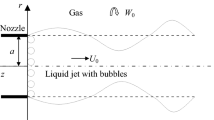Abstract
In this study, a numerical simulation is used to show the physics of a coupled forced perturbation and liquid jet in the presence of a low-velocity coaxial gas flow. The volume of fluid (VOF) approach is employed to capture the liquid–gas interface. A sinusoidal velocity with a finite frequency and amplitude is applied at the liquid jet inlet to define a forced perturbation. An annular gas flow with a velocity lower than that of the liquid jet is imposed to examine its influence on the liquid jet breakup mechanism. The annular gas flow is modulated by the sinusoidal velocity inlet, and the effect of this flow on the liquid jet breakup mechanism is analyzed. Different ratios of the gas velocity to liquid velocity are studied. The results indicate that the low-velocity gas flow can considerably affect the behavior of the liquid jet, and this effect becomes more significant as the amplitude of the forced perturbation increases.






Similar content being viewed by others
REFERENCES
F. Savart “Mémoire sur la Constitution des Veines Liquides Lancées par des Orifces Circulairesenmince Paroi," Ann. Chim. Phys.53, 337–386 (1833).
J. Plateau, Statique Expérimentale et Théorique des Liquides Soumis aux Seules Forces Moléculaires(Gauthier-Villars, Paris, 1873), Vol. 2.
J. W. Strutt (Rayleigh), “On the Instability of Jets," Proc. London Math. Soc. 10, 4–13 (1878).
C. Weber, “Zum Zerfall Eines Flüssigkeitsstrahles," Z. Angew. Math. Mech. 11, 136–154 (1931).
P. Lafrance, “Nonlinear Breakup of a Laminar Liquid Jet," Phys. Fluids 18 (4), 428–432 (1975).
W. A. Sirignano and C. Mehring, “Review of Theory of Distortion and Disintegration of Liquid Streams," Progr. Energy Combust. Sci.26, 609–655 (2000).
S. P. Lin and R. D. Reitz, “Drop and Spray Formation from a Liquid Jet," Annual Rev. Fluid Mech. 30, 85–105 (1998).
N. Ashgriz and A. L. Yarin, “Capillary Instability of Free Liquid Jets," in Handbook of Atomization and Sprays(Springer, New York–Dordrecht–Heidelberg–London 2011), pp. 3–53.
L. Crane, S. Birch, and P. D. McCormack, “The Effect of Mechanical Vibration on the Break-up of a Cylindrical Water Jet in Air," British J. Appl. Phys. 15, 750–763 (1964).
P. D. McCormack, L. Crane, and S. Birch, “An Experimental and Theoretical Analysis of Cylindrical Liquid Jets Subjected to Vibration," British J. Appl. Phys. 16, 395–408 (1964).
G. Meier, S. Loose, and B. Stasicki, “Unsteady Liquid Jets," Fascinat. Fluid Dyn. 45, 207–216 (1998).
S. Heister, M. Rutz, and J. Hilbing, “Effect of Acoustic Perturbations on Liquid Jet Atomization," J. Propuls. Power13, 82–88 (1997).
H. Chaves, F. Obermeier, and T. Seidel, “Fundamental Investigation of Disintegration of a Sinusoidally Forced Liquid Jet," inProc. of the 8th Int. Conf. on Liquid Atomization and Spray Systems, Pasadena, July 16–20, 2000 (Carnegie Mellon Univ., Pittsburg, 2000), pp. 1018–1025.
H. Chaves, H. Glate, F. Obermeier, et al., “Disintegration of Sinusoidally Forced Liquid Jet," in Proc. of the 16th Annual Conf. on Liquid Atomization and Spray Systems, Darmstadt, Germany, September, 2000 (Tech. Univ., Darmstadt, 2000), pp. II-6.1–II-6.6.
F. Geschner, G. Obermier, and H. Chaves, “Investigation of Different Phenomena of the Disintegration of a Sinusoidally Forced Liquid Jet," in Proc. of the 17th Annual Conf. on Liquid Atomization and Spray Systems, Zurich, Switzerland, September 2–6, 2001.
V.‘Srinivasan., A. J. Salazar, and K. Saito, “Modeling the Disintegration of Modulated Liquid Jets Using Volume-of-Fluid (VOF) Methodology," Appl. Math. Model. 35, 3710–3730 (2011).
X. Yang and A. Turan, “Simulation of Liquid Jet Atomization Coupled with Forced Perturbation," Phys. Fluid 29, 022103 (2017).
Y. H. Zhu, F. Xiao, Q. L. Li, et al., “LES of Primary Breakup of Pulsed Liquid Jet in Supersonic Crossflow," Acta Astronaut.154, 119–132 (2019).
I. C. Lee, Y. S. Kang, H. J. Moon, et al., “Spray Jet Penetration and Distribution of Modulated Liquid Jets in Subsonic Cross-Flows," J. Mech. Sci. Technol. 24, 1425–1431 (2010).
J. Shinjo and A. Umemura, “Simulation of Liquid Jet Primary Breakup: Dynamics of Ligament and Droplet Formation," Int. J. Multiphase Flow 36, 513–532 (2010).
J. Shinjo and A. Umemura, “Detailed Simulation of Primary Atomization Mechanisms in Diesel Jet Sprays (Isolated Identification of Liquid Jet Tip Effects)," Proc. Combust. Inst.33, 2089–2097 (2011).
A. Zandian, W. A. Sirignano, and F. Hussain, “Dynamics of a Spatially Developing Liquid Jet with Slower Coaxial Gas Flow," inProc. of the 14th Triennial Int. Conf. on Liquid Atomization and Spray Systems, Chicago, July 22–26, 2018, pp. 1–8.
W. O. H. Mayer, “Coaxial Atomization of a Round Liquid Jet in a High Speed Gas Stream: A Phenomenological Study," Exp. Fluids16, 401–410 (1994).
W. O. H. Mayer and R. Branam, “Atomization Characteristics on the Surface of a Round Liquid Jet," Exp. Fluids 36, 528–539 (2004).
A. Ficuciello, F. Baillot, J. B. Blaisot, and C. Richard, “Investigation of Air-Assisted Sprays Submitted to High Frequency Transverse Acoustic Fields: Droplet Clustering," Phys. Fluid29, 067103 (2017).
J. C. Lasheras and E. J. Hopfinger, “Liquid Jet Instability and Atomization in a Coaxial Gas Stream," Annual Rev. Fluid Mech.32, 275–308 (2000).
D. Kim, O. Desjardin, M. Herrmann, and P. Moin, “Toward Two-Phase Simulation of the Primary Breakup of a Round Liquid Jet by a Coaxial Flow of Gas," in Annual Eesearch Briefs (Center for Turbulence Res., Stanford, 2006), pp. 185–195.
A. Kumar and S. Sahu, “Liquid Jet Breakup Unsteadiness in a Coaxial Air-Blast Atomizer," Int. J. Spray Combust. Dyn. 10, 221–230 (2018).
S. S. Deshpande, L. Anumolu, and M. F. Trujillo, “Evaluating the Performance of the Two-Phase Flow Solver InterFoam," Comput. Sci. Discov. 5, 014016 (2012).
E. Berberovic, “Investigation of Free-Surface Flow Associated with Drop Impact: Numerical Simulations and Theoretical Modeling," Ph. D. Tesis (Tech. Univ., Darmstadt, 2010).
Author information
Authors and Affiliations
Corresponding author
Additional information
Translated from Prikladnaya Mekhanika i Tekhnicheskaya Fizika, 2021, Vol. 62, No. 1, pp. 70–77. https://doi.org/10.15372/PMTF20210108.
Rights and permissions
About this article
Cite this article
Soltani, D., Shafaee, M. BEHAVIOR OF CO-FLOW JETS COUPLED WITH A LONGITUDINAL PERTURBATION. J Appl Mech Tech Phy 62, 63–69 (2021). https://doi.org/10.1134/S0021894421010089
Received:
Published:
Issue Date:
DOI: https://doi.org/10.1134/S0021894421010089




